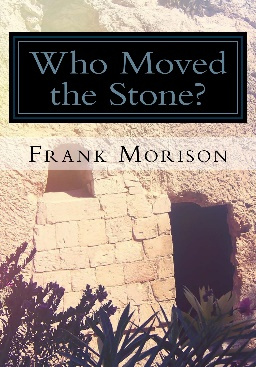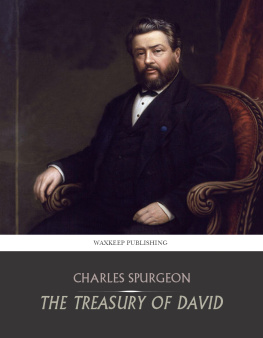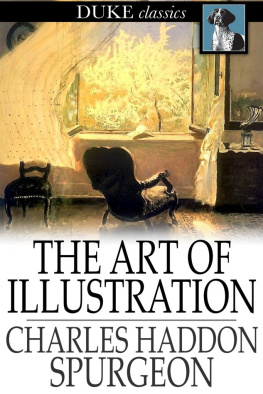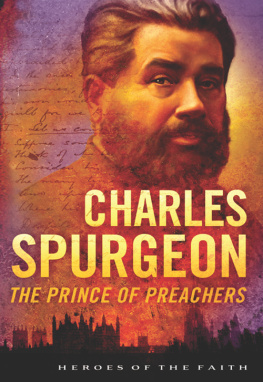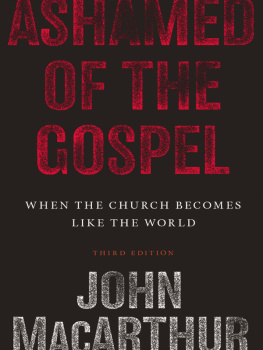CHARLES HADDON
SPURGEON
by
A. CUNNINGHAM BURLEY

Originally published by
THE RELIGIOUS TRACT SOCIETY
65 St. Pauls Churchyard and 4 Bouverie Street, E.C.4, London
Originally Printed by Wm. Clowes and Sons, Ltd. London and Beccles.
First published in London 1838 by The Religious Tract Society.
This edition published in Waterford 2020 by CrossReach Publications.
The main body of this work is in the public domain except where any editing, formatting and/or modernization of the language has been done. All other rights are reserved, including the right to reproduce this edition or portions of it in any form whatsoever without prior written consent from the publisher.
Available in paper and electronic editions. A few select titles are also being published as audiobooks. Please go online for more great works available through CrossReach Publications. If you enjoyed this edition and think others might too, then consider helping us out by leaving a review online, mentioning us by name.
CONTENTS
Charles Haddon Spurgeon
Charles Haddon Spurgeon was one of the outstanding personalities of the Victorian era. He was one of the few ministers who had a world-wide audiencea preacher who had only to whisper to be heard of all men. His life and work are one of the cherished possessions of the scattered English speaking peoples and is a living link which binds many of them together throughout the length and breadth of the earth. It is safe to say that when the history of the wonderful nineteenth century comes to be written, Spurgeon will stand out as one of the most forceful individuals that England has ever seen.
Although he passed away as long ago as the year 1892, yet he still lives in the admiring remembrances of multitudes who heard him. Many of his contemporaries are dead, and although the number of those who came under his spell is daily diminishing, there is no need to fear that Spurgeon is becoming a back number or a fading memory. He will live as long as England lives, because he so laboured and wrought during his all too brief lifetime, as to keep the soul of England alive.
Birth And Childhood
In the kind Providence of God, Spurgeon was born of wise and tender Christian parents. His birthplace was the ancient and obscure village of Kelvedon in Essex. His birthday was June 19, 1834. His parents, John and Eliza Spurgeon, brought up a large family in true Puritan fashion, and it is no wonder that their two sons, Charles and James, should have become distinguished ministers of the Gospel. C. H. Spurgeon (like R. L. Stevenson) as specially favoured in coming under the bracing influence of a venerable ministerial grandfather. At the old Stambourne manse there were many things to appeal to the impressionable mind of a growing child. Those who looked after him were persons of singular simplicity and lovers of innocent habits, and allowed him to have the run of the ministers library and the privilege of meeting the pastors friends.
One of the most notable visitors to the place was the Rev. Richard Knill, missionary at St. Petersburg. Being a soul-winner, he spied out the small boy and took the opportunity of speaking winsomely to him about the love of the Lord Jesus and the joy of loving the Saviour in the enchanted days of childhood. Then followed a most remarkable thing. Mr. Knill took the child on his knee in the presence of all the family and said, solemnly and prophetically, This child will one day preach the Gospel to great multitudes. He then extracted a promise from the boy (supported by the gift of a sixpence) that when, in years to come, he should preach in Rowland Hills Chapel, he would give out the hymn:
God moves in a mysterious way His wonders to perform.
This promise was fulfilled because the prophecy came true. Spurgeon, without seeking to preach in Surrey Chapel, was incidentally asked to do so, and he addressed a gathering of children on the condition that they should sing William Cowpers great hymn. It was done, to the indescribable emotion of the preacher.
Schooldays
Spurgeons schooldays were spent happily and profitably at Colchester, Maidstone, and Newmarket. Being an industrious boy, he never felt the bite of a schoolmasters cane, but qualified in Latin, Greek, and French. Above all, he became an expert penman and laid the foundation for that beautiful, educated handwriting that became in after-life the envy and despair of his friends. Several of his copybooks are still in existence and their careful entries give a more vivid sense of his personality than almost anything else that can be mentioned.
His Conversion
The Story of Mr. Spurgeons conversion is almost too well known to bear repetition. Yet no sketch of his life would approach completeness if no reference to this pivotal experience were made. , The grace of God which had pursued him with many benedictions since his childhood and had encompassed him as with a shield, now began to work more powerfully upon him. For some little time he had been hoping and groping in the shadows of spiritual uncertainty. But on the morning of January 6, 1850, the lad rose early to pray and to read in the hope of finding rest for his troubled soul. Driven forth into a thick, blinding snowstorm, with distress and darkness filling his mind, he entered the Primitive Methodist Chapel in Artillery Street, Colchester. There was a meagre congregation in the spacious vacant pews, and, to use Spurgeons own words, The preacher was a poor uneducated man who had never received a training for the ministry and probably will never be heard of in this life. He was a shoemaker, a tailor, or something of that sort. But the unknown, unlettered man announced his text, Look unto Me and be ye saved, all the ends of the earth. Of exposition there was none, but of personal, pointed application there was a great deal. Fastening his eyes on the dejected looking lad under the gallery, the preacher exclaimed in loud and boisterous tones, Young man, look to Jesus Christ. You have nothing to do but to look and live. That was the supreme moment. Spurgeon said that he could almost have looked his eyes away through sheer rapture and relief. About four months later he was baptized in the River Lark at Isleham Ferry, by Rev. W. W. Cantlow, on May 3, 1850.
There is no portion of the history of men of power more interesting than that which tells how and when they first showed signs of their Strength. This interest is not lacking in the early life of Mr. Spurgeon. On the Saturday following his baptism, he was found eagerly distributing trails. The day following he was in the Sunday School, and a few months later we find him delivering a missionary address to an admiring and appreciative audience.
His First Sermon
Then came his first sermon (an extemporaneous effort) in the little cottage at Teversham. It was an exhilarating experience, enjoyed by speaker and cottagers alike, and there were not wanting those, even in that far-off day, who saw in Spurgeons first sermon the dawn of that popularity which was the beginning of his long and undisputed leadership in religious circles. The country people liked his preaching because of its originality, freshness, and vigour. Moreover, the youthful preacher had the bloom and dew of early manhood upon him, and it was no wonder that his growing fame as an Evangelist-pastor in the Fen District should have ultimately reached London.
Called To London
He had been labouring with phenomenal success for several months as Pastor of the Waterbeach Baptist Church when an overture reached him to become the Minister of New Park Street Chapel, Southwark. But this young man of twenty was reluctant to leave his affectionate little flock in the country for a decaying and unknown cause in London. He came, however, and the immediate effect was tremendous. His preaching captured the hearts of his hearers. His name spread far and wide, and all sorts of people flocked from all kinds of places to hear him. Within one year the great empty chapel had to be enlarged and Exeter Hall had to be requisitioned to accommodate the multitudes that crushed in to hear him. Not that there was anything very bewitching about his personal appearance. His face was heavy with eyelids that drooped as with weight. The nose, cheeks, and lips had a peculiar, sallow, alabaster colour, whilst his broadcloth clothing seemed to hang loose and formless from his corpulent figure. It was when he began to speak that the assembled hosts heard one of the mightiest voices that has ever sounded from a Christian pulpit. There was a clarion sweetness about it that filled the largest building in which Spurgeon held forth. In the Crystal Palace twenty-four thousand persons listened to that voice without effort. Twelve thousand heard it in a field off King Edwards Road, Hackney, while Exeter Hall, Surrey Music Hall, and the vast Agricultural Hall at Islington echoed with its music and its power.
Next page
